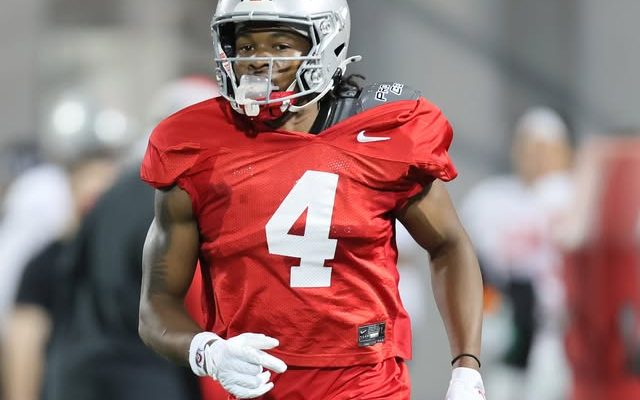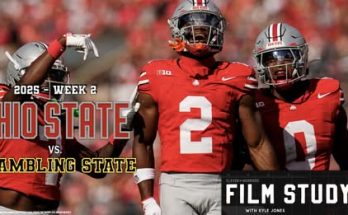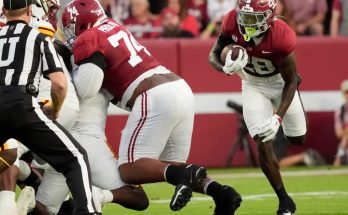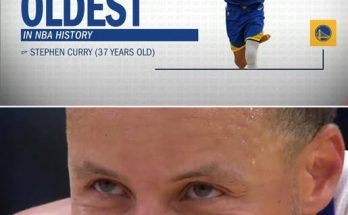**Jeremiah Smith Creates Ohio State’s Mount Rushmore, Omitting Legendary Figures to Stake His Claim Among Buckeyes Greats, Signaling His Confidence**
In the pantheon of Ohio State football, where legends are immortalized and greatness is measured in Heismans, national titles, and iconic moments, few dare to redefine history before even playing a down. But Jeremiah Smith, the Buckeyes’ electrifying freshman wide receiver, isn’t just any recruit. The five-star phenom, already anointed as the next superstar in Columbus, has done the unthinkable: he’s crafted his own version of Ohio State’s Mount Rushmore, deliberately omitting some of the program’s most revered names to plant his flag among the all-time greats before his career even begins.
Smith’s audacious move—a blend of supreme confidence and generational self-belief—has sent shockwaves through Buckeye Nation. While some may call it premature, others see it as the declaration of a player who intends not just to join the legends but to surpass them. His selections, or rather his omissions, speak louder than any hype video or preseason accolade ever could.Before dissecting Smith’s bold revision, it’s essential to acknowledge the near-universal consensus on Ohio State’s football Mount Rushmore. Any credible list includes:
– **Archie Griffin** – The only two-time Heisman winner in college football history, the gold standard of Buckeye greatness.
– **Eddie George** – The 1995 Heisman winner, a bruising running back who defined toughness in the scarlet and gray.
– **Chic Harley** – The early 20th-century pioneer who put Ohio State football on the map, leading the Buckeyes to their first Big Ten titles.
– **Woody Hayes** – The iconic coach who built a dynasty, won five national championships, and embodied Ohio State’s blue-collar identity.
Other names frequently in the conversation include Troy Smith, Orlando Pace, Chris Spielman, and Ezekiel Elliott. The point is, Ohio State’s history is so rich that even narrowing it down to four feels like sacrilege.So, what does Smith’s version look like? In a recent interview, when asked to name his Buckeye Rushmore, he listed:
*Archie Griffin** – The untouchable. Even Smith wouldn’t dare remove the program’s most decorated player.
*Marvin Harrison Jr.** – The recent superstar who rewrote Ohio State’s receiving records before becoming a top NFL Draft pick.
Jeremiah Smith** – Yes, himself.
The omissions are glaring. No Eddie George. No Woody Hayes. No Orlando Pace. No Troy Smith or Ezekiel Elliott. By inserting himself alongside Griffin, Harrison Jr., and Stroud, Smith isn’t just predicting greatness—he’s demanding it.Smith’s exclusion of Buckeye legends isn’t accidental; it’s a statement. By leaving off Eddie George, he subtly positions himself as the next transformative offensive weapon, one who could redefine the program in a way George did in the 90s. By ignoring Woody Hayes, he signals that the modern era—defined by high-flying offenses and NFL-ready skill players—is where his legacy will be built. And by including Marvin Harrison Jr. and C.J. Stroud, he aligns himself with the recent standard of excellence, suggesting he’s next in line to carry that torch.
Most strikingly, Smith’s inclusion of *himself* is unprecedented. Even the most confident Buckeyes—from Terrelle Pryor to Chase Young—waited until they had accomplished something before staking such a claim. Smith, however, operates on a different wavelength. He’s not here to wait his turn; he’s here to take what he believes is already his.What separates Smith from other elite recruits is his unshakable self-assurance. This is a player who, as a high school junior, was already drawing comparisons to Julio Jones and A.J. Green. By his senior year, he was widely considered the best receiver prospect since Calvin Johnson. Ohio State fought off every major program in the country to secure his commitment, and from the moment he stepped on campus, he carried himself like a veteran.
Teammates have raved about his work ethic, but it’s his mindset that stands out. Smith doesn’t just want to be great—he expects it. And in an era where NIL and the transfer portal have reshaped player empowerment, Smith’s willingness to anoint himself as an all-time Buckeye before his first game feels like the natural evolution of modern athlete mentality.
*
Of course, confidence alone doesn’t guarantee immortality. Ohio State’s history is littered with five-star talents who flamed out, derailed by injuries, inconsistency, or the sheer weight of expectations. For Smith to truly justify his self-proclaimed place on the Buckeyes’ Mount Rushmore, he’ll need to deliver at a level few ever have.
That means:
Winning the Biletnikoff Award** (something only two Buckeyes—Terry Glenn and Marvin Harrison Jr.—have done).
*Breaking Harrison Jr.’s records** (single-season receiving yards, touchdowns, etc.).
Leading Ohio State to a national title** (something even Harrison Jr. and Stroud couldn’t accomplish).
Becoming a top-five NFL Draft pick** (cementing his status as a generational prospect).
If he checks those boxes, his audacious claim will look prophetic. If he falls short, it’ll be remembered as premature hubris. But Smith isn’t thinking about failure.Jeremiah Smith’s self-constructed Mount Rushmore isn’t just about rankings or ego—it’s about shifting the paradigm. In an age where athletes control their narratives more than ever, Smith isn’t waiting for permission to call himself a legend. He’s declaring it.
Whether he reaches those heights remains to be seen. But one thing is certain: Ohio State hasn’t seen a player this bold, this self-assured, in a long time. And if his play matches his confidence, the Buckeyes’ record books—and maybe even the real Mount Rushmore of Ohio State football—will have to make room for him.



